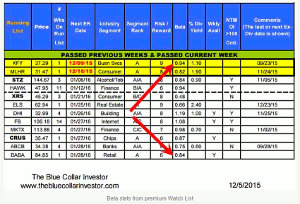Market movement plays a major role in stock and options selections as well as position management choices, so Alan Ellman, of TheBlueCollarInvestor.com, discusses beta-weighting, a technique that can be used to minimize the risk in a portfolio…or at least identify the risk.
What is the impact on the overall market on our covered call writing and put-selling positions? We know that market movement plays a major role in our stock and options selections as well as our position management choices. In this article we will discuss a means of actually measuring the specific sensitivity of our individual positions as well as our overall portfolio to market movement. The technique is known as beta-weighting and has been used by institutional investors for some time and is now available to retail investors who trade with certain online discount brokers such as TD Ameritrade, Options House, and Interactive Brokers, among others.
The sensitivity of an individual stock to the movement in the broader market is known as its beta. Stocks sensitive to market movements typically have high betas (above “1″) whereas stocks that display low correlation with the market have low betas (below “1″), while some may move in line with the market (betas near “1″). Stocks that move inversely to the market have negative betas. Most commonly, beta is measured against the S&P 500 (SPY) but that may vary depending on vendor used and portfolio mix. Stated differently, if the SPY moves a certain amount, how much will that impact our portfolio?
We know that Delta tells us how much our option value will change, given a $1.00 change in share value. If an option for a particular security has a delta of 0.5, it is equivalent to 1/2 share of stock. Stocks always have deltas of ‘1.’ If we are short that option, it is equivalent to (-) 1/2 share of stock. By beta-weighting deltas, options positions can be converted to stock equivalents. By beta-weighting our positions to the S&P 500 we are converting all our positions into one product as a number of shares of SPY. Some positions are long, some short. The closer to Delta-neutral our portfolio, the less impact the market will have on our overall portfolio. A portfolio consisting of positions with offsetting positive and negative Deltas so that the position of delta is zero are said to be Delta-neutral.
Why Beta-weight and Not Just Go with Delta?
All Deltas are not created equal. One hundred Deltas of AT&T (T) have a completely different risk profile than one hundred Deltas of Google. This is because a $1.00 movement in Google (ALPHABET) (GOOG) is much more likely than a $1.00 move in AT&T due to its higher price and greater volatility. When Delta is converted to a beta-weighted Delta, the profit and loss is based on a $1.00 move in the S&P 500, not in the underlying security. By using a beta-weighted Delta, we can see the market risk of any individual position and our portfolio as a whole. Portfolio managers can also use these stats to see the number of Deltas needed to make a portfolio Delta-neutral. Each portfolio Delta position is converted into its Delta-SPY-equivalent. Then positive and negative Deltas are added to determine the total portfolio Delta-SPY equivalent. That number will dictate whether SPY shares need to be bought or sold to create the Delta-neutral portfolio. Portfolio analysis is done using the S&P 500 as the entity to weight securities against.
NEXT PAGE: What About a Delta-neutral Strategy?
|pagebreak|Why do I bring this up?
I have recently received inquiries about a strategy regarding a Delta-neutral covered call writing-like strategy. It goes like this:
- Develop a portfolio of stocks based on the BCI Premium Watch List
- Using the beta-weighting software of our online discount broker, calculate the number of SPY-equivalent Deltas that make up this portfolio (hang in there)
- Buy or sell an equivalent number of SPY option Deltas making the overall portfolio Delta-neutral (I just love our BCI community)
Although we do not beta-weight our portfolios as many institutional investors do, our Premium Watch Lists to provide beta stats in the running list section as shown below:
Stats are based on one year figures with a comparison to the S&P 500.
Discussion
Beta-weighting portfolios is a technique used by some portfolio managers and institutional investors and even some retail investors to minimize the risk in their portfolios or at least identify the risk. This risk is determined by beta-weighting Deltas to SPY equivalents so no matter which securities we have in our portfolio we are always comparing apples to apples. Frequently, the goal is to establish a Delta-neutral, beta-weighted portfolio.
This concept of measuring portfolio and position risk is already accounted for in the BCI methodology by identifying the implied volatility of the underlying security usually by looking at the 1-month return of a near-the-money strike. This may not be as scientific as beta-weighting Deltas but it is practical and effective. For example, in normal market conditions we may set a goal of 2% – 4% for initial returns for near-the-money strikes. We can adjust higher or lower depending on overall market assessment and personal risk tolerance. I am all for any strategy that identifies and accounts for risk management.
By Alan Ellman of TheBlueCollarInvestor.com






















